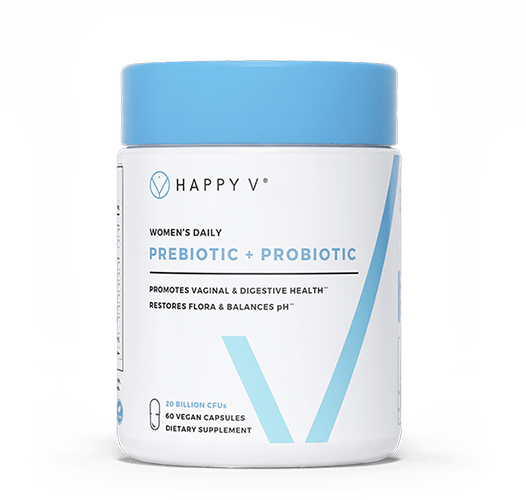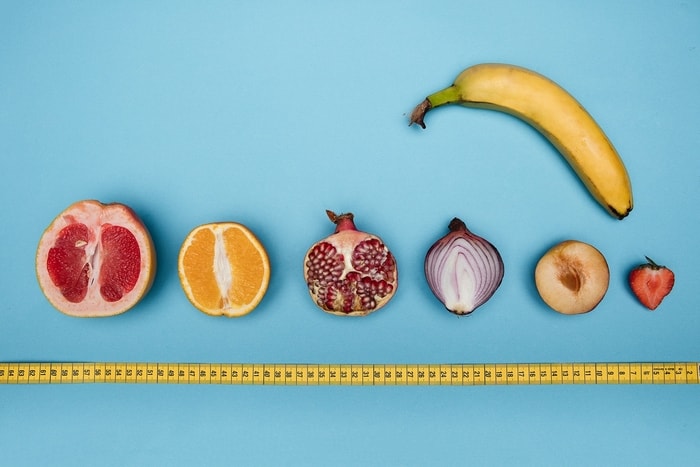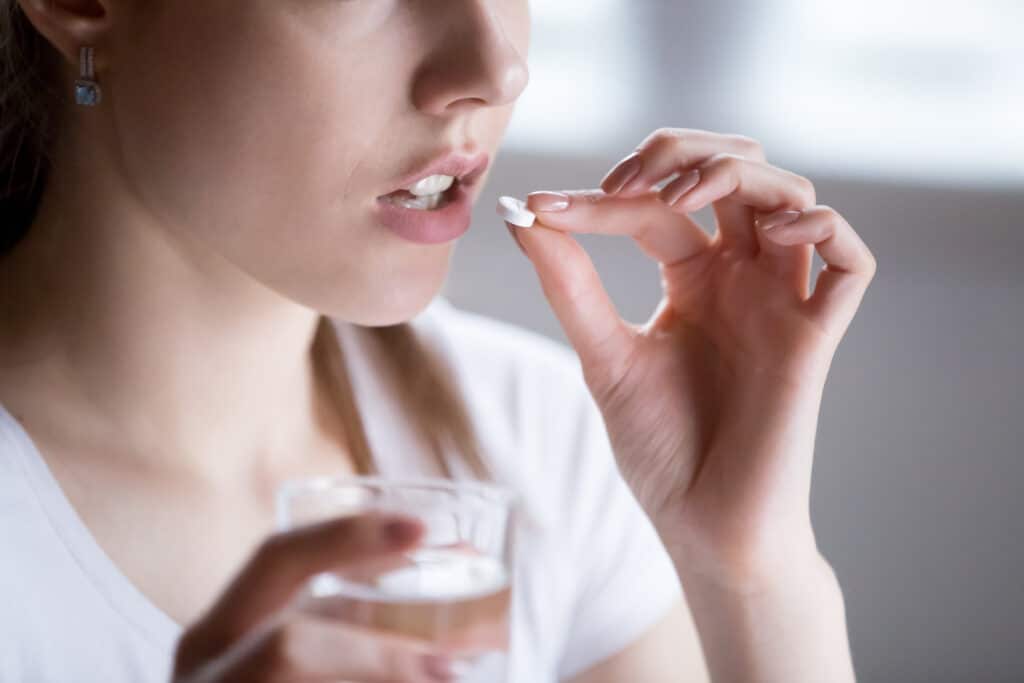- If you’re struggling with a vaginal infection, strange vaginal discharge, or a foul vaginal odor, vaginal pH imbalance may be to blame.
- The ideal vaginal pH is slightly acidic, between 3.8 and 4.5.
- The vaginal microbiome is complex, and things like douching, unprotected sex with multiple partners, and scented soaps can all disrupt that microbiome and alter your vaginal pH.
- Vaginal pH can often be restored and maintained naturally, with a daily probiotic supplement being one of the most effective natural options.
- Lifestyle choices also influence vaginal pH and overall vagina wellness. Avoid unprotected sex, and prioritize exercising regularly, eating a healthy diet, and using good hygiene practices to maintain a balanced and healthy microbiome.
Vaginal pH isn’t exactly top-of-mind for most people. Unless, of course, something has caused your vaginal pH to become imbalanced, and you are struggling with vaginal infections, unusual discharge, or foul odor. Then you think about it A LOT and want to do everything possible to restore your pH levels.
And that’s precisely what we’re diving into here. We’ll share 6 proven, natural ways to get your vaginal pH back to normal, as well as how to prevent it from being disrupted again in the future.
But first, let’s talk about what pH actually is.
What is pH & why does it matter?
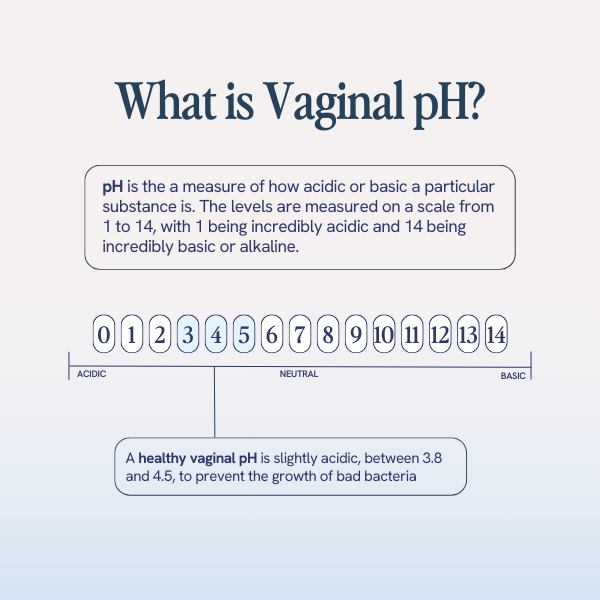
pH measures how acidic or basic something is. It’s calculated using what’s called the pH scale, which ranges from 1 to 14, with 1 being incredibly acidic, 14 being incredibly basic or alkaline, and 7 being neutral.
There’s no universal good or bad when it comes to pH; it all depends on the environment an object or substance is in and how you want it to function. Tomatoes, for example, have a slightly acidic pH of 4, while baking soda is more alkaline, with a pH of 9.
Photo by Deon Black on Unsplash
Believe it or not, all the organs in your body have different pH levels, too. These differences enable different biological processes within the body. The stomach, for example, has a super acidic pH of between 1.5 and 2. This allows the stomach to break down food and kill any bad bacteria that enter your body through the mouth.
What’s a normal Vaginal pH level?
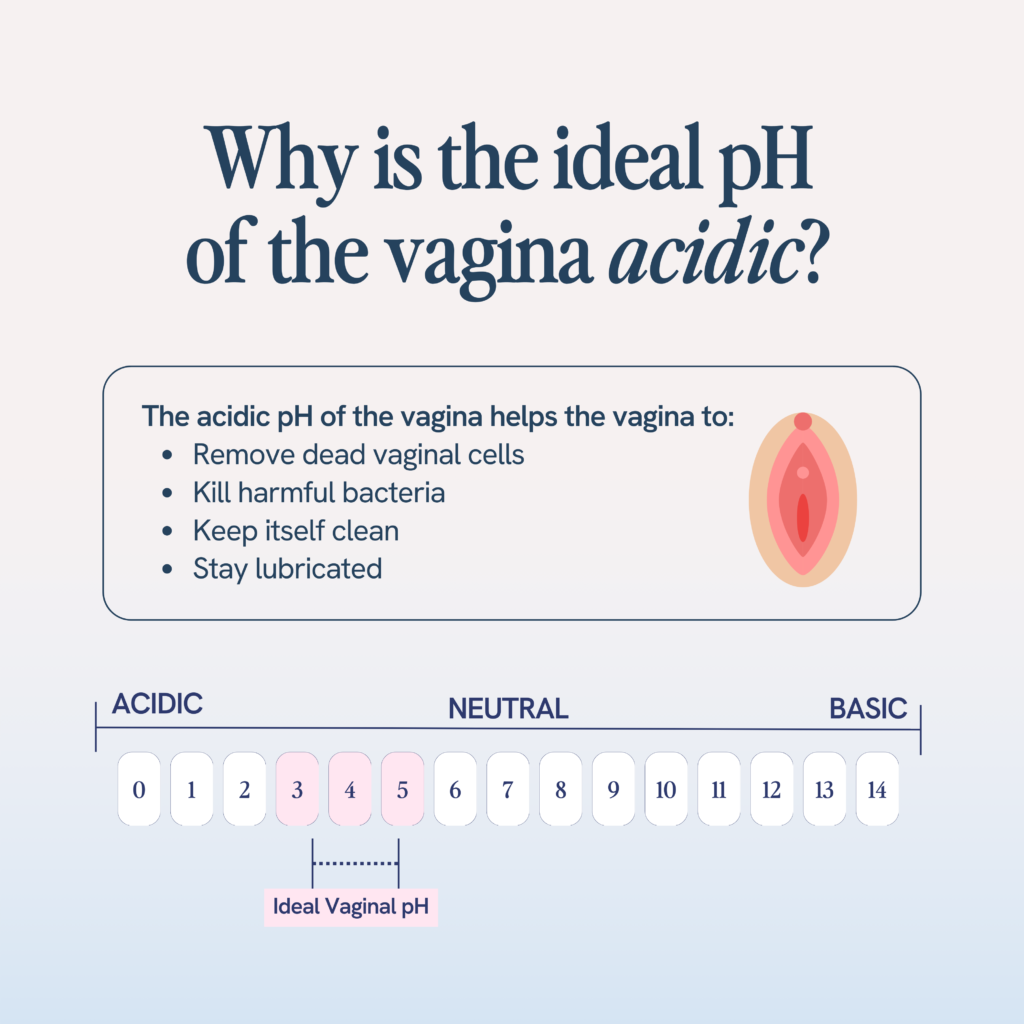
Just like your stomach, skin, and saliva, your vagina has an optimal pH level that keeps it functioning properly. The ideal vaginal pH level is between 3.8 and 4.5, which is mildly acidic. 1
We know “acidic” and “vagina” don’t sound like they should go together, but the vagina’s pH level is important for warding off bacterial infections. Harmful bacteria and microbes are constantly being introduced into the vagina from sex, using the bathroom, and menstruation, and the vagina’s naturally acidic pH kills these bad bacteria while still allowing good bacteria and probiotics to grow and multiply.
How do probiotics influence vaginal pH?

Probiotics within your vagina are actually responsible for maintaining your vaginal pH, particularly a probiotic called Lactobacillus. In the vagina, lactobacillus, especially lactobacillus acidophilus, gasseri, and crispatus, work to convert glucose into lactic acid. This lactic acid contributes to your vagina’s overall acidic pH, which, as we know, is critical for fending off the bacteria that cause the most common vaginal infections, including urinary tract infections (UTIs), bacterial vaginosis (BV), and yeast infections.
Conversely, when you don’t have enough of these Lactobacillus probiotics in your vagina, your vaginal pH levels will rise, making you more prone to bacterial overgrowth and infection.
So, where do these probiotics come from? They often come from eating probiotic-rich foods like yogurt, kefir, and kimchi, but more and more people are taking a prebiotic + probiotic supplement to ensure they are getting the daily probiotics they need to maintain vaginal wellness. If you do add a probiotic supplement to your routine, make sure you look for one like Happy V’s that contains the most effective strains of Lactobacillus since only certain strains have been proven to populate in the vagina.
What things can affect vaginal pH?
The vaginal microbiome in every person is unique and complex, and many decisions and lifestyle factors can disrupt the microbiome, resulting in an unbalanced vaginal pH. Here are some of the most common.
Sexual Intercourse
Sexual activity directly impacts your vagina’s pH because that’s exactly what semen is designed to do. Semen is slightly alkaline, so when it enters the vagina, it raises the pH to make it easier for the sperm to swim. The good news is that this rise in pH is generally temporary, so long as you have adequate Lactobacillus levels.
However, having unprotected sex frequently or having sex with multiple partners does put you at greater risk for developing more chronic vaginal pH issues. So, while we would never say you have to give up sex, if you are struggling with pH imbalance and infections like BV, consider using protection, like a condom, to protect yourself and maintain a healthy microbiome.
Douching
Many see douching as a way to clean the vagina and keep it free from infection, but it can do the opposite. In fact, most healthcare providers advise against douching. When you use a douche, you are clearing your vagina of good bacteria as well as bad. And without the protection of good bacteria, you are more prone to infection.
Vaginal Steaming
Vaginal steaming is another cleansing practice where herbal-infused steam is directed into the vagina. And for the same reasons as douching, it’s also a practice not recommended by doctors.
Scented Soaps
Soaps that are scented, even those marked as “sensitive,” have chemicals that can disrupt your vaginal pH and make you more prone to infection.
So if you can’t use douches, vaginal steams, or scented soaps… what the heck do you use? Despite all these cleansing methods, the vagina is actually self-cleaning. If needed, you can wash the vulva with warm water and mild, unscented soap.
Lubricants
Lubricants can help make sex more comfortable, but those flavored or containing glycerin can increase your vaginal pH, causing irritation or infections like yeast infections. Choose water- or silicone-based lubricants instead.
Menstruation
You can’t exactly avoid getting your period, but you should know that your menstrual cycle can significantly impact your vaginal pH3 so that you can practice good hygiene during this time.
Menstrual blood has a higher pH than your vagina. This is not a problem if the menstrual blood simply flows from your body, but feminine hygiene products like tampons prevent that flow from happening. They trap that menstrual blood in your vagina. If you don’t change these products frequently, that blood can impact your vaginal pH.
Frequent Swimming
Swimming is kind of a double-whammy when it comes to vaginal pH because of the contact with chlorinated water and your tight swimsuit. First, as we discussed with scented soaps, chlorine also contains chemicals that can affect the bacteria within your microbiome. And as for swimsuits, bad bacteria love wet places, and tight swimsuits not only retain water but give very little room for your vagina to breathe, creating an ideal environment for infection-causing microbes.
Photo by Erik Dungan on Unsplash
Hormone Fluctuations
We already talked about what happens during a woman’s menstrual cycle, but certain hormonal birth controls, like pills and IUDs, as well as menopause, change your overall hormone levels, which can disrupt your vaginal pH and make you more prone to infections. 4
How can I naturally restore my vaginal pH?
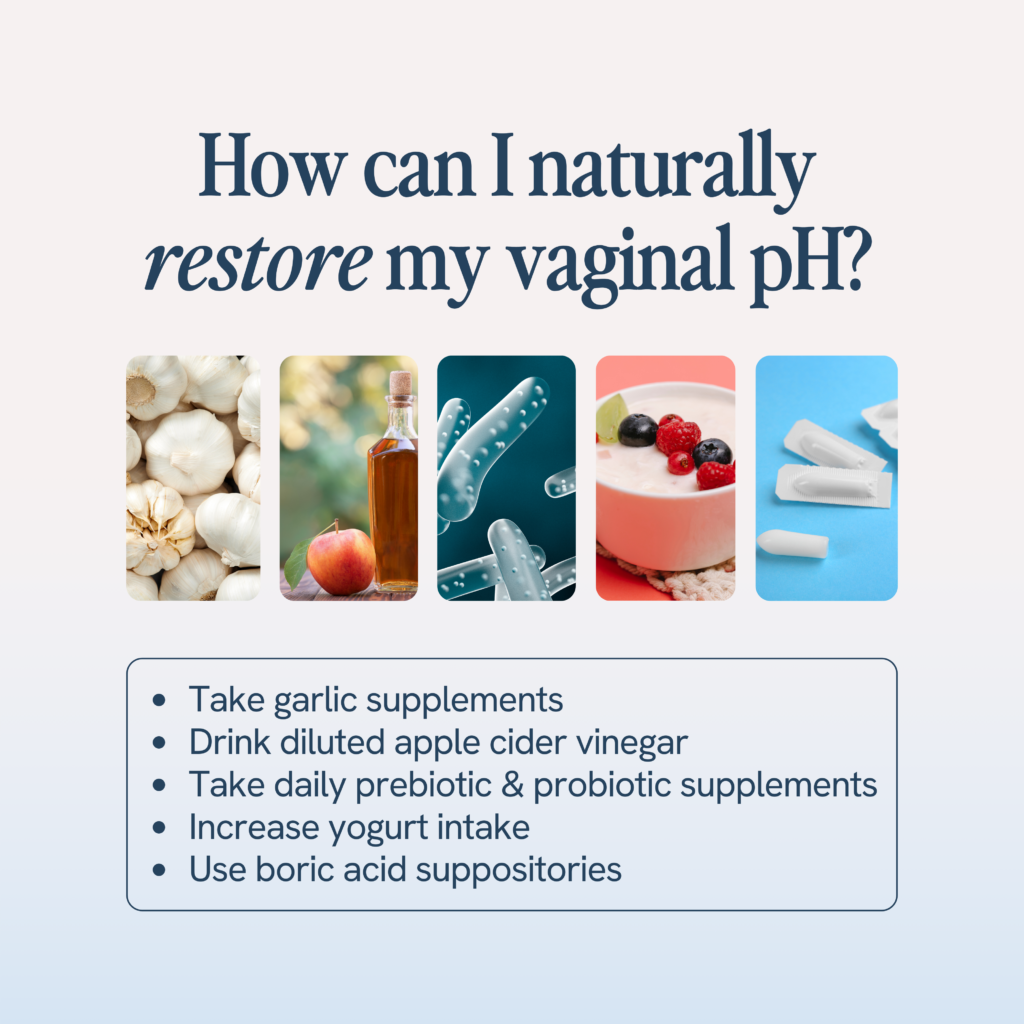
If you aren’t experiencing any itchiness, changes in vaginal discharge, or foul odor from the vagina, you probably don’t need to think too much about your vaginal pH. The absence of these things is a good sign that everything is as it should be.
However, if you are experiencing these issues, you may want to look into ways you can begin to restore your vaginal pH. Here are 6 ways you can do that naturally.
- Increase your yogurt intake.
Yogurt is one of those probiotic-rich foods we mentioned earlier, with an exceptionally high concentration of Lactobacilli. Adding yogurt along with kefir and other probiotic-rich foods to your diet will help replenish your good bacteria stores and strengthen your immune system. 5
Yogurt is one of those probiotic-rich foods we mentioned earlier, with an exceptionally high concentration of Lactobacilli. Adding yogurt along with kefir and other probiotic-rich foods to your diet will help replenish your good bacteria stores and strengthen your immune system. 5
2. Take a daily probiotic supplement.
Yogurt is a great way to get your probiotics… but what if you don’t like yogurt? Or what if you don’t want the added sugars that can come with most yogurts? That’s where a daily probiotic comes in.
Daily probiotic supplements are an easy, targeted way to support vaginal health and restore vaginal pH. And we are sure you are no stranger to the fact that probiotic supplements are having a heyday right now. But evidence supporting daily probiotic supplements actually goes back to the early 1970s, when Canadian urologist Andrew Bruce pioneered the treatment of vaginal infections by replenishing vaginal Lactobacillus levels.
Subsequent research has supported Bruce’s treatment methods, showing that Lactobacillus can effectively lower the chances of contracting urinary tract infections, yeast vaginitis (thrush), and bacterial vaginosis. 7
Research that has studied Lactobacillus-containing probiotic supplements supported this finding, proving these supplements are clinically effective against vaginal infections and pH changes. 8-10
The way probiotic supplements help are by:
- Optimizing your gut health and improving your gut function
- Boosting your immune system
- Supporting your natural vaginal flora
- Maintaining your vaginal pH
- Fighting off bad bacteria
- Alleviating any signs and symptoms of BV or vaginal yeast infection
- Improving your vaginal health and wellness
And as we mentioned earlier, probiotic supplements are basically everywhere right now, available as capsules, powders, drinks, and suppositories. However, not all of these supplements are created equal. Some can make a huge difference in your health, while others are just a huge waste of money. So, how can you spot the difference?
1. Read labels. This is a must when it comes to any health supplement. Check for and avoid any artificial ingredients, additives, or preservatives.
2. Make sure the supplement uses clinically proven strains of probiotics in doses that are proven to be clinically effective. 11 There are many, many strains of Lactobacillus out there, but not all of them are proven to impact vaginal health and vaginal pH. Look for strains like Lactobacillus acidophilus, gasseri, and crispatus
3. Look at Colony Forming Units or CFUs, but remember, a higher number isn’t always better. Studies have shown that the best probiotic supplement for vaginal pH imbalance or vaginal infections should contain anywhere between 500 million to 50 billion CFUs.12 Supplements that contain less than that are not dosed to be effective, and supplements that have far more than that are likely not using the effective strains of Lactobacillus.
These 3 things should steer you in the right direction next time you are at the pharmacy. But if you want to save yourself a trip, check out Happy V’s doctor-formulated probiotic for vaginal health. We promise it checks all these off your list and more. It’s got thousands of 5-star reviews, and we will deliver it straight to your door.
Our Happy V® Prebiotic + Probiotic was created for anyone who is experiencing symptoms related to Bacterial Vaginosis and Yeast Infections. Eliminate the odor, itch, gut bloating, and other symptoms.
3. Take prebiotics.
Prebiotics can actually help make probiotics more effective. Prebiotics are essentially plant-based fibers that nourish the probiotics, making it easier for probiotics to flourish and maintain their numbers.13, 14
Prebiotics naturally exist in foods like asparagus, sugar beet, garlic, chicory, onion, Jerusalem artichoke, wheat, honey, banana, barley, tomato, rye, soybean, human’s and cow’s milk, peas, and beans. 14
But of course, prebiotics are also available as a supplement. Some supplements, like our Prebiotic + Probiotic, even combine them with probiotics, making them easy to remember every day.
4. Drink diluted apple cider vinegar.
Apple cider vinegar, or ACV, contains acetic acid, which has strong antibacterial and antifungal properties, meaning it can help fight off bad bacteria and fungus that may enter your vagina and cause BV and yeast infections.15 In addition to acetic acid, ACV has lactic acid, which we know is essential for maintaining an ideal pH.
Please do not apply apple cider vinegar directly to your vagina; don’t add it to your bathwater, either. Instead, take a spoonful and put it in a glass of water. If you’re not a fan of the taste, throw in a spoonful of honey, too, to help it go down easier.
5. Use a boric acid suppository.
Boric acid is a mild antiseptic and antifungal that’s long been used as an over-the-counter treatment for vaginal infections like BV or candida. It’s a naturally occurring compound containing boron, oxygen, and hydrogen (H3BO3). 16
The Centers for Disease Control and Prevention (CDC) recommends taking 600mg of boric acid suppositories once daily for 21 days as an alternative treatment option for vaginal yeast infection. But as for restoring a disrupted vaginal pH, specifically, the research is still out.
If you want to try boric acid, it’s affordable and readily available at local pharmacies. They mostly come as suppositories, meaning they are meant to be inserted directly into your vagina.
6. Take garlic tablets.
Garlic is a go-to natural remedy for all kinds of ailments. That’s because it’s rich in antioxidants and other bacteria-fighting compounds such as allicin. 17
There are some experts out there that recommend inserting garlic vaginally; we highly recommend just adding it into your diet or taking odorless garlic capsules and tablets. There is great evidence of the potential of garlic when combined with metronidazole when taken orally.18
But if you do have an interest in this method, garlic tablets are not without risk and should be taken cautiously if you are on blood thinners or have bleeding concerns. As with any of the remedies we just listed, it’s best to consult your gynecologist before taking them.
What lifestyle changes restore or maintain healthy vaginal pH?
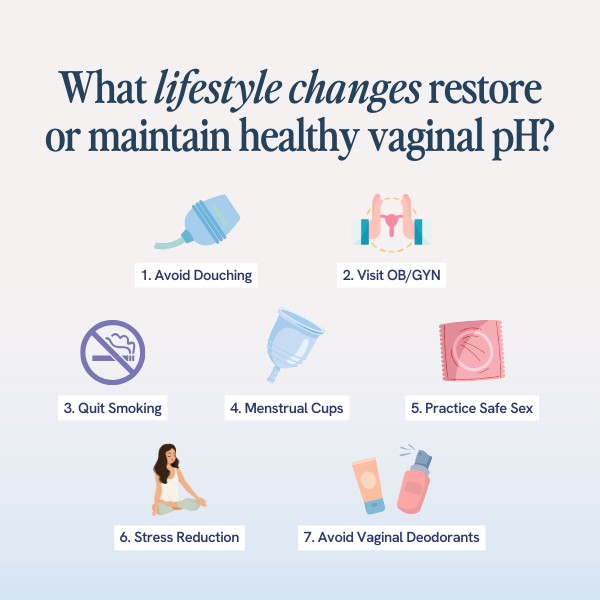
Whether you are struggling with vaginal infections and pH imbalance or simply want to maintain your current level of vaginal health, these lifestyle decisions can help.
1. Avoid douching
We already mentioned how douching can make you more prone to pH imbalance, not less. But it’s worth reiterating because douching has been associated with health problems such as:
● Vaginal dysbiosis
● Increased risk of sexually transmitted infections (STIs)
● Increased risk of vaginal infections like BV and vaginal yeast infections
2. Destress yourself
Chronic stress is associated with a whole host of ills, including high blood pressure, weight gain, heart problems, migraines, vaginal pH imbalance, and sexual health problems. 19
That’s because chronic stress leads to the overproduction of a stress hormone called cortisol, and high cortisol levels have been associated with an increased risk of BV.20
Mild, day-to-day stress is inevitable, but if you are feeling more stressed than not, consider setting aside time every day to combat your anxiety directly. The two most common ways to destress include exercise and deep breathing.
Physical activity and exercise – Exercise can cut stress levels in half thanks to the endorphins they produce. Activities like yoga and tai chi are beneficial in releasing endorphins and reducing stress.
Deep breathing – Daily exercise can take time out of your schedule, but reaping the benefits of deep breathing can take as little as 5 minutes. Deep breathing can help oxygenate your blood, which in turn clears your mind.
Hobbies are another great way to destress and get your mind off of worries and into something fun. Hobbies can be as intricate as woodworking or gardening or as easy as playing a board game.
3. Stop smoking
As if its link to cancer and other diseases wasn’t compelling enough, smoking also makes you more likely to develop bacterial vaginosis and UTIs.21
A pilot study conducted in 2010 studied the vaginal flora of smokers vs non-smokers and found that non-smokers have more Lactobacilli bacteria in their vaginal microbiota than smokers, which we know helps maintain vaginal pH and fight infection-causing bacteria. 21
And we know it’s tough to quit smoking, but it isn’t impossible, and your doctor is a great ally. They can help you create a smoking cessation plan and even prescribe various medications or alternative therapies like nicotine patches to make quitting easier.
4. Keep your vulva clean
Remember, fragrant cleansers, wipes, or vaginal deodorants are a no-no. But cleaning your vulva with warm water and mild soap, especially before and after intercourse, can help prevent infection. And when wiping your anus, always wipe from front to back.
5. Have protected sex
This is another one we mentioned earlier, but unprotected sex is a common cause of pH imbalance. Using condoms during intercourse can help prevent these imbalances. And if your current condom of choice ever causes irritation or discomfort, consider switching to a latex-free condom.
6. Choose menstrual cups over tampons
Tampons not only soak up that alkaline menstrual blood and keep it close to the vaginal walls, they can also cause dryness and chafing, making you more prone to infections.
Menstrual cups do not soak up blood nor allow it to stay in contact with your vagina. The blood is collected in the cup and doesn’t affect your vaginal pH.
7. See a healthcare provider or OB/GYN regularly.
While at-home pH tests exist and the websites like this one can be a wealth of knowledge, it’s important to not self-diagnose or self-medicate, especially if you are experiencing vaginal infection symptoms like foul-smelling discharge, unusually thick or thin discharge, and white or gray-colored discharge.
Many vaginal infections share symptoms but require different treatments to resolve them correctly. A doctor is the best person to make an accurate diagnosis and get you on the path to feeling well again.
- Lin Y-P, Chen W-C, Cheng C-M, Shen C-J. Vaginal pH value for clinical diagnosis and treatment of common vaginitis. Diagnostics. 2021;11(11):1996.
- Petrova MI, Lievens E, Malik S, Imholz N, Lebeer S. Lactobacillus species as biomarkers and agents that can promote various aspects of vaginal health. Frontiers in physiology. 2015;6:81.
- WAGNER G, OTTESEN B. Vaginal physiology during menstruation. Annals of internal medicine. 1982;96(6_Part_2):921-923.
- Farage MA, Miller KW, Sobel JD. Dynamics of the vaginal ecosystem—hormonal influences. Infectious Diseases: Research and Treatment. 2010;3:IDRT. S3903.
- Rawlings D. Fermented Foods for Health: Use the Power of Probiotic Foods to Improve Your Digestion, Strengthen Your Immunity, and Prevent Illness. Fair Winds Press; 2013.
- Borges S, Silva J, Teixeira P. The role of lactobacilli and probiotics in maintaining vaginal health. Archives of Gynecology and Obstetrics. 2014/03/01 2014;289(3):479-489. doi:10.1007/s00404-013-3064-9
- Reid G, Jass J, Sebulsky MT, McCormick JK. Potential Uses of Probiotics in Clinical Practice. Clinical Microbiology Reviews. 2003;16(4):658-672. doi:doi:10.1128/cmr.16.4.658-672.2003
- Sieber R, Dietz U-T. Lactobacillus acidophilus and Yogurt in the Prevention and Therapy of Bacterial Vaginosis. International Dairy Journal. 1998/07/01/ 1998;8(7):599-607. doi:https://doi.org/10.1016/S0958-6946(98)00096-X
- Recine N, Palma E, Domenici L, et al. Restoring vaginal microbiota: biological control of bacterial vaginosis. A prospective case–control study using Lactobacillus rhamnosus BMX 54 as adjuvant treatment against bacterial vaginosis. Archives of Gynecology and Obstetrics. 2016/01/01 2016;293(1):101-107. doi:10.1007/s00404-015-3810-2
- Homayouni A, Bastani P, Ziyadi S, et al. Effects of probiotics on the recurrence of bacterial vaginosis: a review. Journal of lower genital tract disease. 2014;18(1):79-86.
- Salminen S, Isolauri E, Salminen E. Clinical uses of probiotics for stabilizing the gut mucosal barrier: successful strains and future challenges. Antonie Van Leeuwenhoek. 1996;70:347-358.
- Wang Z, He Y, Zheng Y. Probiotics for the Treatment of Bacterial Vaginosis: A Meta-Analysis. International Journal of Environmental Research and Public Health. 2019;16(20):3859.
- Manning TS, Gibson GR. Prebiotics. Best practice & research clinical gastroenterology. 2004;18(2):287-298.
- Davani-Davari D, Negahdaripour M, Karimzadeh I, et al. Prebiotics: definition, types, sources, mechanisms, and clinical applications. Foods. 2019;8(3):92.
- Saqib A. Antimicrobial activity of apple cider vinegar. Mapana Journal of sciences. 2017;16(2):11-15.
- Dinesh S, Ajit P, Madhav P, Chetan P, Prachi P. Study of antifungal activity of boric acid on vaginal pathogens. Int J Adv Biotechnol Res. 2013;4(3):319-323.
- Prasad K, Laxdal VA, Yu M, Raney BL. Antioxidant activity of allicin, an active principle in garlic. Molecular and Cellular Biochemistry. 1995;148:183-189.
- Mohammadzadeh F, Dolatian M, Jorjani M, Alavi Majd H, Borumandnia N. Comparing the therapeutic effects of garlic tablet and oral metronidazole on bacterial vaginosis: a randomized controlled clinical trial. Iran Red Crescent Med J. Jul 2014;16(7):e19118. doi:10.5812/ircmj.19118
- Qi H, Wen F-Y, Xie Y-Y, et al. Associations between depressive, anxiety, stress symptoms and elevated blood pressure: Findings from the CHCN-BTH cohort study and a two-sample Mendelian randomization analysis. Journal of Affective Disorders. 2023/11/15/ 2023;341:176-184. doi:https://doi.org/10.1016/j.jad.2023.08.086
- Amabebe E, Anumba DO. Psychosocial stress, cortisol levels, and maintenance of vaginal health. Frontiers in endocrinology. 2018:568.
- Brotman RM, He X, Gajer P, et al. Association between cigarette smoking and the vaginal microbiota: a pilot study. BMC infectious diseases. 2014;14(1):1-11.
Check out Our Prebiotic + Probiotic, designed to help rebalance pH levels
- A-
- A+
Check out Our Prebiotic + Probiotic, designed to help rebalance pH levels
